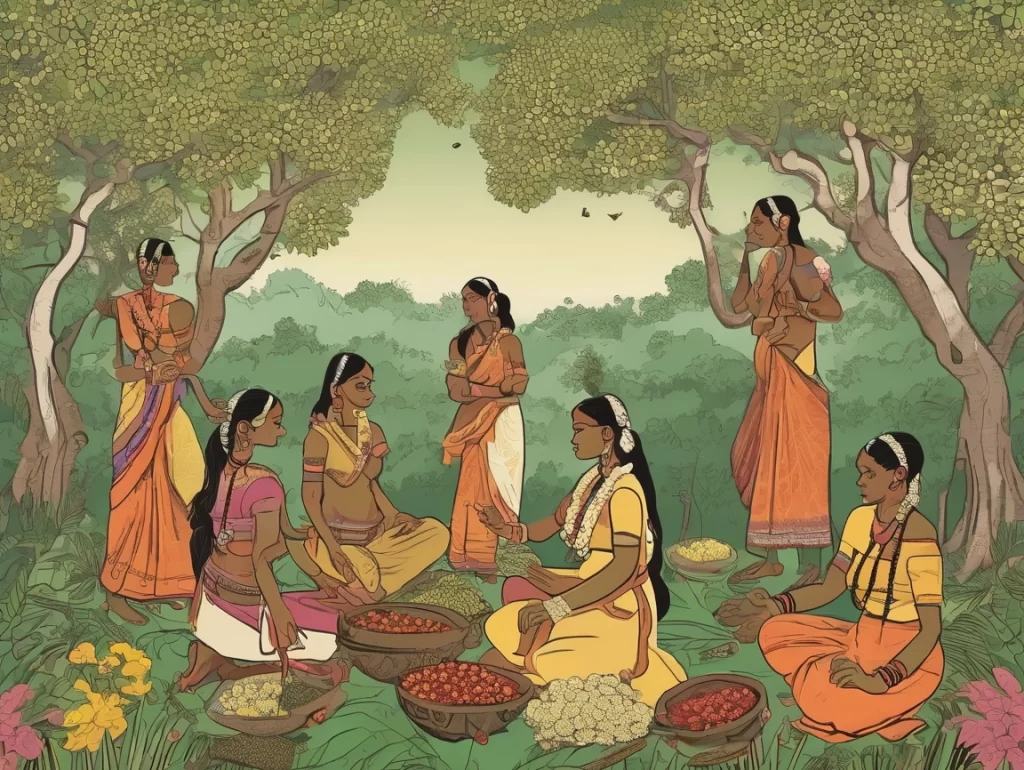A Tree Wrapped in Misunderstanding
Across India’s forests, when the first sunlight filters through the sal and mahua trees, tribal life begins with the fragrance of freshly fallen flowers.
For centuries, Mahua (Madhuca longifolia) has been a source of food, medicine, and livelihood.
Yet, in popular imagination, the word “Mahua” often brings one thought — liquor.
Many people still ask:
“Will I get high if I eat Mahua flowers?”
The short answer: No. Mahua does not cause intoxication.
The confusion exists because Mahua flowers are used in traditional liquor making — but it is not the flower that intoxicates; it is the fermentation process that produces alcohol.
Just as grapes are used to make wine, rice to make beer, and barley to make whiskey — eating any of these foods does not make you drunk.
The same logic applies to Mahua: the flower is food, not alcohol.
The Science: Fermentation, Not the Flower, Causes Alcohol
Let’s understand this scientifically yet simply.
What Happens During Fermentation?
Fermentation is a natural biological process where yeasts (microorganisms) convert sugars into ethanol (alcohol) and carbon dioxide under the absence of oxygen.
Mahua flowers contain natural sugars — mainly fructose and glucose — which are excellent food sources for yeast.
When the flowers are soaked in water for several days and left undisturbed, wild yeasts start acting on these sugars.
The result? Alcohol is formed.
However, if you dry, cook, or eat Mahua flowers directly, there is no fermentation, hence no alcohol and no intoxicating effect.
🍇 Just as fresh grapes are healthy, but fermented grapes become wine —
🍚 Just as rice is staple food, but fermented rice water becomes beer —
🌼 So too, Mahua is a nutritious flower that becomes alcoholic only after fermentation.
Nutritional Powerhouse of the Forest
Far from being intoxicating, Mahua is an energy-rich, medicinal, and nourishing superfood.
Here’s what the flower naturally contains:
| Nutrient | Health Benefit |
|---|---|
| Fructose & Glucose | Provide instant natural energy. |
| Iron (Fe) | Builds red blood cells, prevents anemia. |
| Calcium & Phosphorus | Strengthen bones and teeth. |
| Vitamin C & B-complex | Boost immunity and metabolism. |
| Potassium & Magnesium | Maintain heart and nerve function. |
| Antioxidants | Detoxify the body and slow ageing. |
Mahua is low on glycemic index, making it a gentle natural sweetener suitable even for moderate use by diabetics.
It provides sustainable nutrition — especially in forest and rural regions where access to fruits or supplements is limited.
Ayurvedic Perspective: Mahua as “Madhuka”
In Ayurveda, Mahua is known as Madhuka, classified under the Sapotaceae family.
It is revered not as a stimulant, but as a rejuvenating, cooling, and healing herb.
A verse from Bhavaprakasha Nighantu describes its essence beautifully:
“मधुकं मधुरं शीतं गुरु स्निग्धं बलप्रदम्।
मुखरोगहरं चैव व्रणशोषणकारकम्॥”
(Bhavaprakasha Nighantu, Mishrakadi Varga)
Meaning:
Mahua (Madhuka) is sweet, cooling, heavy, and nourishing. It strengthens the body, heals wounds, and cures oral ailments.
Ayurvedic Properties
| Property | Sanskrit Term | Description |
|---|---|---|
| Taste (Rasa) | Madhura (Sweet) | Nourishing, calming for mind and body. |
| Qualities (Guna) | Snigdha, Guru | Moisturizing, grounding, and heavy. |
| Potency (Virya) | Sheeta | Cooling in nature; pacifies excess heat and pitta. |
| Post-digestive effect (Vipaka) | Madhura | Builds tissues and improves digestion. |
| Specific Action (Prabhava) | Balya, Vranaropana, Pittashamak | Strength-giving, wound-healing, pitta balancing. |
Thus, Mahua is mild, cooling, nourishing, and restorative — the opposite of what alcohol does to the body.
Why the Confusion Exists
The misunderstanding surrounding Mahua is mostly cultural.
During the colonial and early post-independence eras, the term “Mahua liquor” became widespread because many tribal communities fermented Mahua flowers for local beverages.
However, this traditional beverage was originally a controlled, ceremonial drink, consumed only in small quantities during festivals like Sarhul or Bastar Dussehra.
Over time, outsiders commercialized and associated Mahua solely with alcohol, overshadowing its food and medicinal value.
The result — a tree revered for centuries became wrongly labeled as a “liquor tree”.
Today, as scientific research and community initiatives like Jai Jungle revisit these traditions, Mahua is regaining its rightful identity as a food, not a narcotic.
Safe and Traditional Ways to Eat Mahua
There are several traditional and modern ways to consume Mahua safely, without any trace of alcohol:
1. Dried Flower Powder
Sun-dried Mahua flowers are ground into a fine powder and mixed with milk, porridge, or warm water.
It provides instant energy and acts as a natural tonic for fatigue and anemia.
2. Mahua Laddoos and Cookies
Blending Mahua powder with millets, nuts, and ghee creates Mahua Laddoos and Cookies — nutritious, wholesome, and kid-friendly.
They serve as natural energy boosters for students, farmers, and athletes.
3. Mahua Tea or Infusion
Steeping Mahua flowers with herbs like tulsi, ginger, or cinnamon in hot water creates a mild immunity-boosting tea.
It soothes sore throats and supports digestion.
4. Modern Nutraceutical Forms
Innovative ventures like Jai Jungle have transformed Mahua into safe, standardized, and scientifically validated products —
such as ForestGold Vanyaprash, Mahua Nectar, and Mahua Infusion.
These are non-fermented, purely plant-based preparations that retain all nutritional and Ayurvedic benefits — without alcohol.
Health Benefits Backed by Tradition and Science
- Boosts Energy & Relieves Fatigue:
Natural sugars and minerals provide sustained energy without caffeine or stimulants. - Improves Digestion:
A small dose of Mahua powder or syrup supports gastric balance and nutrient absorption. - Blood Builder (Raktavardhak):
Rich in iron, Mahua helps increase hemoglobin and combats anemia — especially in women. - Cooling and Pitta-balancing:
Sheeta virya property cools the system, reduces inflammation, and soothes ulcers. - Antioxidant Protection:
Compounds like flavonoids neutralize free radicals, delaying ageing and boosting immunity. - Oral and Throat Health:
Decoctions made from Mahua bark and flowers are traditional remedies for gum swelling, mouth ulcers, and sore throats. - Reproductive and Hormonal Health:
Tribes often use Mahua as a post-menstrual strength tonic — its balya (rejuvenating) effect helps restore energy.
Mahua as a Symbol of Tribal Wisdom
In India’s forest regions — from Chhattisgarh and Jharkhand to Odisha and Maharashtra — Mahua is not just a tree, it’s an emotion.
Every spring, when the tree sheds its creamy-yellow blossoms, women gather them at dawn, singing songs that celebrate renewal and abundance.
The act of collecting Mahua is as sacred as the act of sowing rice — both sustain life.
For centuries, these women have preserved not just the flowers, but also the knowledge of how to use them wisely — as food, medicine, and community wealth.
Jai Jungle’s work embodies this same philosophy:
reviving ancient forest wisdom through safe, women-led, and science-backed innovation.
Their initiative ensures that the world sees Mahua not as liquor, but as India’s forest-born superfood.
Mahua vs. Alcoholic Products: A Simple Comparison
| Parameter | Mahua Flower (Edible) | Fermented Mahua (Liquor) |
|---|---|---|
| Process | Dried, cooked, or powdered | Fermented by yeast |
| Alcohol Content | None | 12–18% ethanol |
| Taste | Naturally sweet and floral | Sharp and bitter |
| Effect on Body | Cooling, nourishing | Heating, dehydrating |
| Ayurvedic Nature | Sheeta virya, Balya | Ushna virya, Kshaya-karaka (depleting) |
| Health Impact | Positive | Harmful if excessive |
Thus, the same flower can either heal or harm — depending on how humans process it.
Mahua and Sustainability
Mahua trees require no irrigation, fertilizers, or pesticides.
They grow naturally in dry tropical forests, enriching biodiversity.
By collecting fallen flowers instead of cutting trees, communities sustain both ecology and economy.
When women-led groups process Mahua hygienically — drying, grading, and packaging it for foods and nutraceuticals — they create a circular, sustainable value chain:
- Nature gives the resource
- Communities add value
- Consumers receive wellness
- Forests stay protected
This model represents true green entrepreneurship, exactly what Jai Jungle stands for.
The Real Face of Mahua
It’s time to change how the world sees Mahua.
The flower itself is not intoxicating — it nourishes, cools, and heals.
It is the fermentation process, not the flower, that produces alcohol.
Mahua is a bridge between tribal wisdom and modern nutrition science, between forest culture and sustainable innovation.
Its sweetness carries no intoxication — only the deep serenity of the earth.
When we understand Mahua in its true form —
as food, as medicine, as empowerment —
we not only restore the dignity of a tree but also the identity of the communities who have cherished it for generations.
🌿 Mahua is not liquor — it is life, livelihood, and legacy.

